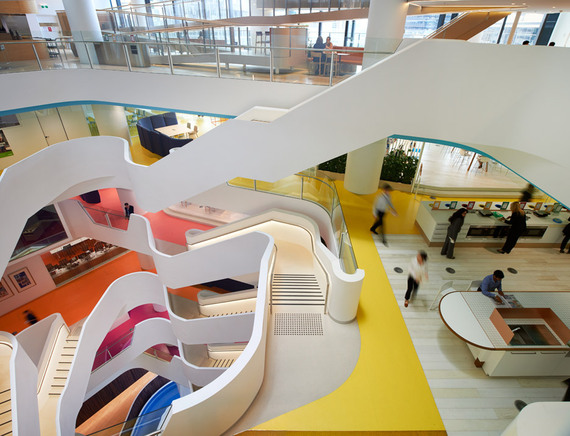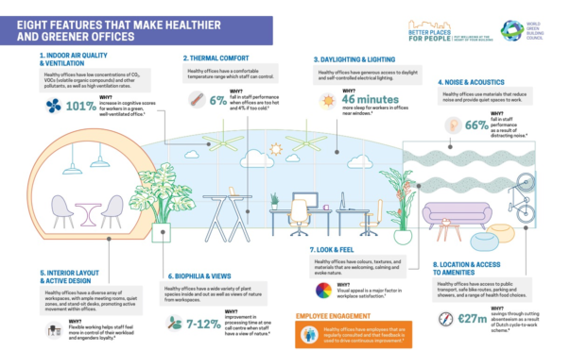The evidence is growing daily that organizations of all sizes stand to benefit by creating buildings which improve the health and wellbeing of their occupants.
People are the most valuable resource of an organization, typically accounting for 90% of business operating costs, so even a 1% improvement in productivity can have a major impact on the bottom line and competitiveness of any business.
Since 2014 the World Green Building Council have undertaken to put wellbeing at the heart of buildings and demonstrate the business value of doing so through their Better Places for People initiative. Their latest report: Building the Business Case: Health, Wellbeing and Productivity in Green Offices, highlights the global momentum behind healthy and green office design and operation and showcases over 15 buildings from around the world that are leading the way. World Green Building Council CEO, Terri Wills says the report presents "overwhelming evidence between office design and improved health and wellbeing of workers and demonstrates tangible action businesses are taking to improve their workspaces."
Simple steps like improving air quality, increasing natural light and introducing greenery - which typically have environmental benefits such as using less energy - can also have a dramatic impact on the bottom line by improving employee productivity and reducing absenteeism, staff turnover and medical costs.
The World Green Building Council have developed a simple framework to help companies take action. The framework issues calls for organisations to assess key environmental factors which affect health and wellbeing, survey employees to find out how they experience them, and measure the economic factors they influence, such as productivity, absenteeism and medical costs.
Eight Features that Make Healthier and Greener Offices
The report identifies eight key factors in creating healthier and greener offices which can impact on the bottom line.
- Air Quality & Ventilation - a well-ventilated office can double cognitive ability
- Thermal Comfort - staff performance can fall 6% if offices are too hot and 4% if they too cold
- Daylighting & Lighting - a study found people in offices with windows get 46 minutes more sleep a night
- Noise & Acoustics - noise distractions led to 66% drop in performance and concentration
- Interior Layout and Active Design - flexible working helps staff feel more in control of workload and encourages loyalty
- Biophilia & Views - processing time at one call centre improved by 7-12% when staff had a view of nature
- Look & Feel - visual appeal is a major factor in workplace satisfaction
- Location & Amenities - a Dutch cycle to work scheme saved €27m in absenteeism.
The Impact of Working in a Green Certified Building on Cognitive Function and Health, is a new study from Harvard University and SUNY Upstate Medical University that makes the case for green and WELL certification. It suggests that occupants of high-performing, certified green buildings had nearly a third (30 percent) fewer sick building symptoms, a 6.4 percent higher sleep quality score and a 26.4 percent higher cognitive function score, compared to people in high-performing buildings without green certification.
Australia continues to be the global market leader of proving healthy and green workplaces that improve the wellbeing of people, boost productivity and contribute to the bottom line. One of the Australian workplaces highlighted is Medibank's new office in Melbourne which is the centrepiece of a culture change programme for Australia's largest health insurer. The plant-filled building includes 26 types of workspaces, from tranquil areas to collaborative hubs, fireplaces on every floor, herb gardens, sports facilities and a program of curated community events. The benefits are significant; two in three staff feel healthier, 80 per cent are working more collaboratively and absenteeism is down five per cent.
There are also some excellent examples around the world:
French manufacturing giant Saint-Gobain's call centre staff at its new North American headquarters, in Malvern, Pennsylvania, doubled their productivity after moving into the new building, with a 97% increase in sales-generated leads and 101% increase in leads per call. The building has a fitness centre, 1.3 miles of walking trails, more than 100 collaborative workspaces, and 92% of offices have outdoor views.
Swedish construction and development company Skanska, was able to cut sick days by two-thirds after it rebuilt its office in Doncaster, improving indoor air quality, cutting down on noise levels and installing a central light well that increased the natural daylight in the building. The company was able to save £28,000 ($34,209) in staff costs in 2015, and achieve a 34% increase in overall employee satisfaction.
Employee satisfaction and engagement is known to boost productivity: a Gallup meta-analysis of 1.4 million employees found that companies with a high level of engagement reported 21% higher productivity.
As Wills says "The results are clear - putting both health and wellbeing, and the environment, at the heart of buildings, is a no brainer for businesses' employees and the bottom line."


